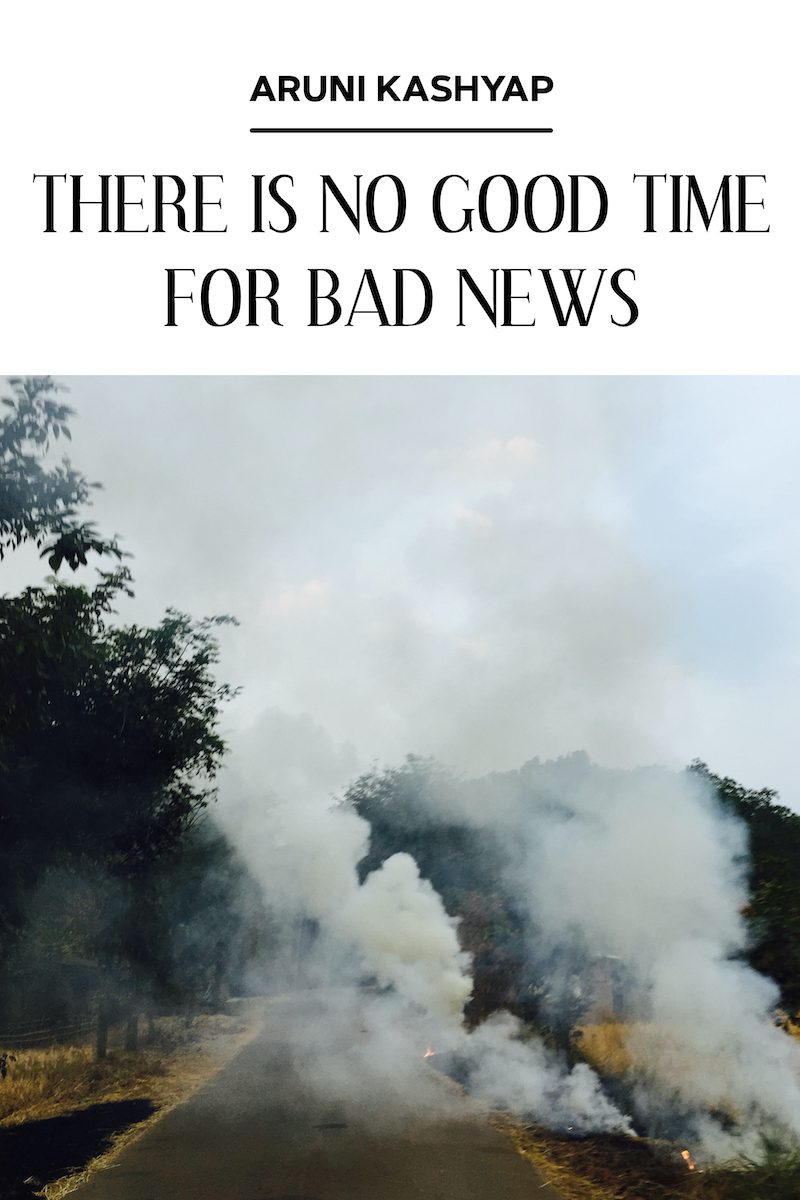I bought Aruni Kashyap’s collection There Is No Good Time for Bad News because the title put words to the experience of living through 2020. The near-constant state of anxiety, of living in the pandemic, of feeling helpless when confronted by the horrors committed by state security forces as with the murder of George Floyd, and with the awareness of the constant torture inflicted by Israeli forces on the people of Palestine.
Amidst this hopelessness, I have also felt energized by the transformative power of bearing witness. The video of George Floyd murder sparked a global movement against racism and police brutality. More recently, video testimonies of Israeli brutality have fueled wider support for Palestinian freedom from state-sanctioned violence. Still, there are places where the earth is wet with blood spilled through state-sanctioned violence, places where, despite the ubiquity of technological penetration around the world, many stories of state-sanctioned violence never come out.
Aruni’s homeland, the Indian state of Assam, is one such place, where news from home comes only “If the wind chooses to carry it / against the wishes of the media, governments.” Assistant Professor of Creative Writing at the University of Georgia, Aruni Kashyap’s body of work—which includes novel, short stories, and poems in English as well as his native Assamese—interrogates the condition of living through and resisting the violence of the state.
I fell in love with his newest collection because it folds testimony into poetry. In June, we spoke on the phone for two hours, discussing There Is No Good Time for Bad News, the connections between human rights and literature, and the way in which stories can create space for justice.
***
The Rumpus: You have written novels, short stories, and poems. What is at the heart of all your writing?
Aruni Kashyap: I use my writing to generate and sustain conversations about justice—about conversations that will uphold democratic principles. To achieve this, I have often returned to my roots, my home in Assam. I use this location sometimes as a canvas, sometimes as a lens, to comment on the vagaries of the Indian nation-state. Assam is one of those marginal locations that enables me to see India differently. It is one of those states that waged an armed insurgency against Indian rule, trying to secede. In these poems, I am trying to critique the atrocities of the Indian state by using oral narratives where I foreground the stories of survivors from a nearly forgotten or lesser-known armed insurgency. This exercise is an artistic exploration to see the possibilities of oral stories and an act of bearing witness for me as a tribal writer from northeast India.
Rumpus: Your poetry collection takes the form of testimonials. Testimonials are often the tool for journalists, but you incorporate testimonials in your poems. What led to the choosing of poetry as a vessel for your testimonials?
Kashyap: This poetry collection is made of monologues in the voices of people who have survived violence. These monologues or narratives are also about those who didn’t make it. So, in a sense, the survivors in these poems are telling their stories with the hope that one day, someone would know what they went through, and this knowledge of a distant and imaginary person would lead to a conversation to ensure justice. For many who faced injustice, the hope that someone would know their story is the only justice they can dream for. I found inspiration in the testimonial genre in Latin American literature, to give shape to these accounts.
I also thought that the idea of a testimonial, of someone coming to an imaginary witness box and narrating what they went through publicly, is powerful. We have seen how healing and enabling it was for the survivors of violence in post-apartheid South Africa at the Truth and Reconciliation Commission. We need truths to come out. We must create situations for survivors of any kind of social violence to come out and tell their stories so that we can bring the perpetrators to at least a public trial. I think literary forms of social engagement, such as the testimonio form, enable such possibilities.
When I started researching my first novel, The House with a Thousand Stories, in 2009, I came across numerous stories of people who had suffered unspeakable atrocities. The novel was about a series of extra-judicial killings in India during the late 1990s to quell an insurgency in Assam. A lot of the stories I came across didn’t make it to the novel, and I wanted to find a way of recording them, of honoring them. I thought poetry would be the best way to do this: it gives me the artistic freedom to tell more in a small amount of time; it gives me the artistic challenge of inhabiting other bodies, which is a goal of any good writing, especially fiction. The verse form also liberates me from the documentary or journalistic form, and allows me to use a format that I know best: storytelling. But overall, you know, the testimonial form is rebellious; it says that it will record what the state tried to erase.
Finally, as an Indigenous writer from India, I know the value and power of oral stories. The violence that these characters face results from colonialism. It is only through a potent anti-colonial tool such as oral narratives of Indigenous people that one can challenge official narratives and colonial narratives.
Rumpus: What was the process of collecting these testimonials?
Kashyap: I talked to people in rural communities. That was easy for me because most of my family lives in villages, and they had faced the brunt of the armed conflict between the insurgents and the Indian security forces. I talked to many people, mostly people in my extended family who had survived army atrocities, violence from the insurgents, and so on. I also read a lot of Assamese-language memoirs and court proceedings, talked to journalists who covered the insurgency, and read through archives of folded newspapers.
Rumpus: What was the artistic challenge and the reward of turning testimonies into a work of literature?
Kashyap: The artistic challenge was to keep aside my anger, to channel it into finding beauty amid the brutality. During the writing, I noticed that it was only provocative when I wrote from a place of anger—not radical. But when I started honoring the voices of the survivors, inhabiting their bodies, and the recorder, the intellectual in me stepped aside and remained silent, their characteristics emerged: they would refuse to die, refuse to eat, refuse to stop speaking. The academic me, the intellectual me, who knows literary theory, who has read books, is a useless entity, a hindrance in this process of imaginative reconstruction: too correct, too guilt-ridden, too woke. When he stepped again, magic started happening. The voices of the survivors took precedence, delight emerged, and I was able to find a language through their voices. I guess this is what Carolyn Forché means when she discusses language and the poetry of witness—a language that “bear wounds” and this is “legible in the line breaks, in constellations of imagery, in ruptures of utterance, in silences and fissures of written speech.”
Rumpus: Writing about violence that happens on the margins of the modern world is sometimes too easily labeled “literature of conflict.” One of your short stories, “Skylark girl,” is about resisting the stereotype. What is lost when a work of literature is labeled as a conflict story?
Kashyap: I think the media, the publishing industry, and the awards often fetishize topicality. This is seen so much in the American literary establishment’s regular award functions, the corporate press, the manuscript wish-lists of literary agents. Sadly, as contemporary writers, we have to make our way through it. As a result of this fetishization, we often get simple, sensationalist stories; there are many. Please don’t make me name them! I value topicality in literature, but I resist that fetishization.
How do you do that? By focusing on all kinds of stories, and even when you address the topicality, you have to honor the voiceless voice. I think Indigenous cultures have been doing that always: my short story, “Skylark Girl,” based on an Assamese folk tale that you mention, is about a girl who refuses to give up on life. But the neoliberal literary culture doesn’t like that because survivors don’t let you gawk. Survivors question, resist, and refuse to be bracketed into simple narratives: he writes conflict stories; they write only X kind of stories; she writes ABC fiction. In a sense, survivors try to reclaim the agency powerful structures have denied them. So, we have to continue telling stories that are urgent and topical but have to focus on stories of people who have survived, so that we can be better ancestors by leaving inspiring stories to our next generation.
There will be all kinds of emotions in these stories, but the focus would be on people who refuse to give up on life, as the young girl in my story refuses to. Unfortunately, the Western publishing industry is interested in the suffering, not survivalist narratives, of the global South instead. The corporate publishing industry wants these sufferings to be depicted according to the terms of the publishing professionals, by forcing people to situate their stories in settings familiar to the dominant reading public. Then Americans complain that American fiction writers are denied the Nobel.
Anyway, sorry about my aside: what I meant to say is that, by fetishizing conflict, the forces of the neoliberal literary marketplace flatten complex experiences and the diversity of locations, histories, and cultures that the literary imagination has to offer. My first novel is set against a violent period, but it also has a very long sex scene that goes for pages because it is about how people lived and loved and consumed life despite the violence. It is also about what it means to live in a large joint family in South Asia. It is about coming of age at a time of strife. To call my work conflict literature is to reduce it, flatten it.
Rumpus: In our previous conversations, you have used the term “horrorism,” fatigue and anxiety of living under the constant threat of violence. Frequently, testimonials assume that the act of violence is a thing of the past. Yet, your poems often bear witness to events that have an ongoing, unnerving present-ness to it. What is the value of testimonials when the violence is recurring and the vast majority gives their tacit approval or indulges in perpetuating acts of violence?
Kashyap: Yes, I think we don’t have the most accurate language to describe what it means to live under the constant threat of violence. We use words such as terror, conflict, but by calling it horrorism—a word that the book Horrorism by Adriana Cavarero popularized—we are looking at the violence, the insecurity, the constant anxiety, from the point of view of the victims who didn’t make it, and the survivors who made it and lived to tell the tale. But what is the value of stories or survivors when the vast majority of people allow that violence through explicit and implicit approval; sometimes, they even celebrate this horror.
I think that takes me back to what I started this conversation with: for some, the hope that someone would know their stories is the only hope and the only kind of justice they can expect. I heard this from several journalists who covered the conflict: the people who lived through the violence were eager to share their stories even though they knew that they would probably never read them, watch those media reports. Why did they do that? This is why. Because the hope that someone would know gave them satisfaction, meaning, courage. Hence, it is our duty to tell these stories and create a conducive atmosphere for more stories of survivors to come out until they have the necessary atmosphere to tell their stories. This is how democracy is sustained.
***
Photograph of Aruni Kashyap courtesy of Aruni Kashyap.





